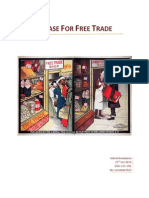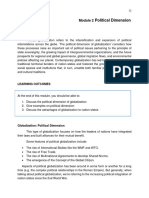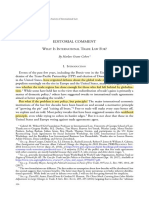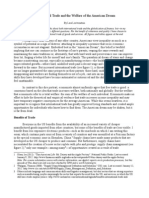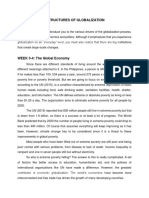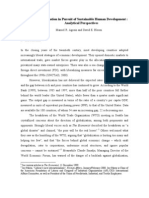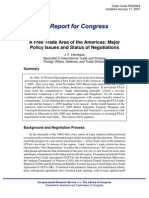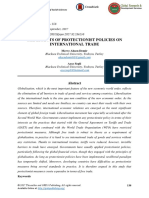Running Head: The Emerging Markets of Latin America 1
Running Head: The Emerging Markets of Latin America 1
Uploaded by
davidinmexicoCopyright:
Available Formats
Running Head: The Emerging Markets of Latin America 1
Running Head: The Emerging Markets of Latin America 1
Uploaded by
davidinmexicoOriginal Description:
Original Title
Copyright
Available Formats
Share this document
Did you find this document useful?
Is this content inappropriate?
Copyright:
Available Formats
Running Head: The Emerging Markets of Latin America 1
Running Head: The Emerging Markets of Latin America 1
Uploaded by
davidinmexicoCopyright:
Available Formats
Running head: THE EMERGING MARKETS OF LATIN AMERICA
Taking Advantage of the Emerging Markets of Latin America David Gilley Thomas Edison State College International Management/MAN-372-OL009 October 31, 2013 Professor Baker
THE EMERGING MARKETS OF LATIN AMERICA Abstract (if needed)[replace]
[According to the Publication Manual of the American Psychological Association (APA), An abstract is a brief, comprehensive summary of the contents of the article; it allows readers to survey the contents of an article quickly and, like a title, it enables persons interested in the document to retrieve it from abstracting and indexing databases (2010, p. 25). The first line of the abstract is not indented. An abstract may range from 150 to 250 words (APA, 2010). Because an abstract is not always required for student papers, adhere to your instructors requirements. ]
THE EMERGING MARKETS OF LATIN AMERICA Taking Advantage of the Emerging Markets of Latin America In todays world, there is an increasing trend towards globalization, or the increasing interdependence of different countries and economies. This is a complex process that involves a
multitude of factors which are debated even by expert economists; however, there are undeniable factors that are involved which, when identified, can help to achieve successful participation in the global marketplace. There are many different ways to participate and to benefit from globalization, but they all require a strategic focus on the particular market in question. One fatal error, regardless of the strategy chosen, is to fall into the belief that different cultures and situations around the world are essentially the same. This oversimplification is dangerous because it tends to focus only on superficial issues, while serious social and cultural gaffes can take place because of the individuals false belief that the differences are insignificant or nonexistent. Other factors which must be considered in developing a strategy for the Latin American market include political and legal barriers to trade, which present a certain level of risk in any market, but are especially volatile in certain emerging markets (Hill, 2011, p. 33). Globalization and Drives of Globalization Declining Barriers to Trade One of the primary factors which has been driving the ever-increasing globalization of the market is the steady reduction of barriers to trade in most countries throughout the world. This phenomenon began after the Second World War, and has contributed immensely to the huge increase in trade between foreign countries (Hill, 2011, p. 11). The past sixty years have seen many different international treaties and trade agreements which have had the goal of encouraging international commerce while at the same time attempting to protect domestic jobs and economies. The General Agreement on Tariffs and Trade is one example, and the
THE EMERGING MARKETS OF LATIN AMERICA negotiation concerning the fomenting of a greater flow of goods and services between nations with minimal barriers has played a significant role in reducing average tariff rates and in
encouraging nations to stand by the agreements made. The GATT also led to the founding of the World Trade Organization in 1995 to provide a more effective policy-setting and conflict resolution environment (WTO, 2012). Another important agreement was the North American Free Trade Agreement, or NAFTA, which governs trade between the U.S., Canada, and Mexico. NAFTA was signed by all three countries, and took effect on January 1st, 1994. It was hotly debated, and very publicized, as many different groups felt that it may hurt long-term interests, and that it unfairly favored large corporations and firms (Burfisher, Robinson, & Thierfelder, 2001). In the end, however, it has made Mexico a much more attractive location for U.S. businesses, and also a great source of raw materials or components. Heading for Section 2 of Your Paper (Must be bold!) [Cover the second main topic of your paper in this section.] Heading for Section 3 of Your Paper (Must be bold!) [Cover the third main topic of your paper in this section.] Conclusion [This is the where the conclusion of your paper goes.]
THE EMERGING MARKETS OF LATIN AMERICA References
Hanging indent for all references. To keep this format, simply place the cursor at the front of this line and paste or type your reference material. Then press enter. Remember to organize your references alphabetically. Remember to delete this line of text and any other template text before submitting your paper.
You might also like
- Pest Analysis of LibyaDocument14 pagesPest Analysis of LibyaHarshada ChavanNo ratings yet
- Free TradeDocument9 pagesFree Tradeapi-263291630No ratings yet
- Opening America's Market: U.S. Foreign Trade Policy Since 1776From EverandOpening America's Market: U.S. Foreign Trade Policy Since 1776Rating: 5 out of 5 stars5/5 (1)
- (S3) Butler Lumber - EnGDocument11 pages(S3) Butler Lumber - EnGdavidinmexicoNo ratings yet
- UNWTO Tourism 2020Document28 pagesUNWTO Tourism 2020Sofija Petronijevic100% (1)
- UNIT 1 MODULE 2 GLOB Political Dimension OKDocument8 pagesUNIT 1 MODULE 2 GLOB Political Dimension OKKent RodriguezNo ratings yet
- Economics RealityDocument7 pagesEconomics RealityGera VillaNo ratings yet
- North American Free Trade Agreement NaftaDocument18 pagesNorth American Free Trade Agreement NaftaSergioLópezNo ratings yet
- Trading Blocs and Multilateralism in The World EconomyDocument16 pagesTrading Blocs and Multilateralism in The World Economynaim1004No ratings yet
- What Is International Economics? International Economics: Is A Field of A Study That Assess The Implications ofDocument4 pagesWhat Is International Economics? International Economics: Is A Field of A Study That Assess The Implications ofjamesmwala2002No ratings yet
- What Is International Trade Law ForDocument21 pagesWhat Is International Trade Law ForMikeal SharchNo ratings yet
- Market IntegrationDocument36 pagesMarket IntegrationJessa CapuchinoNo ratings yet
- Trade- Neoclassical Liberal Views on ImpactsDocument17 pagesTrade- Neoclassical Liberal Views on ImpactsFabioNo ratings yet
- The Political Economy of International Trade: Helen V. MilnerDocument24 pagesThe Political Economy of International Trade: Helen V. MilnerMaruSharonNo ratings yet
- Globalisation, GATS and Trading in Education Services: Susan L. RobertsonDocument17 pagesGlobalisation, GATS and Trading in Education Services: Susan L. RobertsonAjay GargNo ratings yet
- Loewenstein - International Trade and The Welfare of The American DreamDocument7 pagesLoewenstein - International Trade and The Welfare of The American DreamlloewensNo ratings yet
- NAFTA's Developmental Impact On Mexico: Assessment and ProspectsDocument24 pagesNAFTA's Developmental Impact On Mexico: Assessment and ProspectsMila KarmilaNo ratings yet
- The Causes of GlobalizationDocument51 pagesThe Causes of GlobalizationBCH SAN LUISNo ratings yet
- Abolish WTO - AffirmativeDocument4 pagesAbolish WTO - AffirmativeMatthewNo ratings yet
- Catching Up What Are The Critical Factor For Success - Fagerberg Dan SrholecDocument88 pagesCatching Up What Are The Critical Factor For Success - Fagerberg Dan SrholecMa'ruful MusthofaNo ratings yet
- Resisting The Protectionist Temptation - Industry and The Making of Trade Policy in France and The United States During The 1970sDocument28 pagesResisting The Protectionist Temptation - Industry and The Making of Trade Policy in France and The United States During The 1970sAleixandre Brian Duche PérezNo ratings yet
- ECO 615 Unit 1 LectureDocument11 pagesECO 615 Unit 1 LecturebuhleymapNo ratings yet
- International Political Economy Beyond Hegemonic StabilityDocument10 pagesInternational Political Economy Beyond Hegemonic StabilityRaikaTakeuchiNo ratings yet
- Eco Intre DennvDocument10 pagesEco Intre DennvIlman's JourneyNo ratings yet
- Chapter 2: The Structures of GlobalizationDocument7 pagesChapter 2: The Structures of GlobalizationJudessa Mae Pronce CadacioNo ratings yet
- A World of Trading BlocsDocument14 pagesA World of Trading BlocsAzhar KhanNo ratings yet
- Milner SummaryDocument2 pagesMilner SummaryAndreas Dettwiler100% (1)
- Global Integration in Pursuit of Sustainable Human Development: Analytical PerspectivesDocument25 pagesGlobal Integration in Pursuit of Sustainable Human Development: Analytical PerspectivesCarmel PuertollanoNo ratings yet
- I Be Ra Antiglobalization For SharingDocument22 pagesI Be Ra Antiglobalization For Sharingmonk0062006No ratings yet
- Tema 7 EpiDocument11 pagesTema 7 Epimaría graciaNo ratings yet
- 05Fagerberg-Srholec CatchingUp PDFDocument88 pages05Fagerberg-Srholec CatchingUp PDFTee SiNo ratings yet
- IPE ExamDocument3 pagesIPE ExamJM Hernandez VillanuevaNo ratings yet
- Contempo Module 3Document14 pagesContempo Module 3Mercyjoy GarciaNo ratings yet
- International Trade Homework Assignment 2Document3 pagesInternational Trade Homework Assignment 2hameed afridiNo ratings yet
- Has Globalization Gone Too FarDocument96 pagesHas Globalization Gone Too Farleanhthuy100% (1)
- Washington ConsensusDocument5 pagesWashington Consensusmaheshaper89No ratings yet
- ASSESSMENT Two ContempoDocument7 pagesASSESSMENT Two ContempoJackie Lou Romero100% (1)
- Agriculture Law: RS20864Document6 pagesAgriculture Law: RS20864AgricultureCaseLawNo ratings yet
- International Relations Thesis ExamplesDocument5 pagesInternational Relations Thesis Examplesfc2frpq5100% (1)
- Master of Business Administration - MBA Semester 4 MB0037 - International Business Management Assignment Set-1Document36 pagesMaster of Business Administration - MBA Semester 4 MB0037 - International Business Management Assignment Set-1Araj99No ratings yet
- Lecture 2 Modified IPE OatleyDocument55 pagesLecture 2 Modified IPE Oatleysakibabsar115No ratings yet
- l.2 The Global Economy Part 2. 2022Document46 pagesl.2 The Global Economy Part 2. 2022Ma. Simeona PatigayonNo ratings yet
- Ibt Group1 Part2Document60 pagesIbt Group1 Part2Rose MarieNo ratings yet
- Best Business Books 2002: Globalization: Two Cheers For Free TradeDocument6 pagesBest Business Books 2002: Globalization: Two Cheers For Free TradeDaniela GarzonNo ratings yet
- WTO Whose Trade PDFDocument6 pagesWTO Whose Trade PDFhujjatunaNo ratings yet
- MGT282. International Business Assignment Essay QuestionsDocument4 pagesMGT282. International Business Assignment Essay QuestionsJoyce JohnsonNo ratings yet
- Why Is Globalisation ControversialDocument20 pagesWhy Is Globalisation ControversialDanku MártonNo ratings yet
- IPE ExamDocument3 pagesIPE ExamJM Hernandez VillanuevaNo ratings yet
- annotated-IR Research AssignmentDocument8 pagesannotated-IR Research AssignmentmqobongoaNo ratings yet
- Aaronson, S A - Taking Trade To The Streets - The Lost History of Public Efforts To Shape GlobalizaDocument284 pagesAaronson, S A - Taking Trade To The Streets - The Lost History of Public Efforts To Shape GlobalizaPedro Gomes Andrade100% (1)
- International Financial Markets: The Challenge of GlobalizationFrom EverandInternational Financial Markets: The Challenge of GlobalizationLeonardo AuernheimerNo ratings yet
- Globalization: Neutrality DisputedDocument43 pagesGlobalization: Neutrality DisputedmuradhashimNo ratings yet
- Bounded by The Reality of TradeDocument19 pagesBounded by The Reality of TradeMírian ScalabriniNo ratings yet
- The Effects of Protectionist Policies On International TradeDocument23 pagesThe Effects of Protectionist Policies On International TradeGlobal Research and Development ServicesNo ratings yet
- Tema 0. ICRDocument6 pagesTema 0. ICRot2023juantinNo ratings yet
- Internal Bussiness Management MU0037 Set-1Document24 pagesInternal Bussiness Management MU0037 Set-1Sudha Amit ThakurNo ratings yet
- Pug87488 FMDocument20 pagesPug87488 FMgloriaNo ratings yet
- MULTILATERALISMDocument27 pagesMULTILATERALISMJepter Lorde100% (1)
- Globalization Law and Development - Introduction and Overview (GLDocument13 pagesGlobalization Law and Development - Introduction and Overview (GLKaran GillNo ratings yet
- Intra-Industry Trade: Cooperation and Conflict in the Global Political EconomyFrom EverandIntra-Industry Trade: Cooperation and Conflict in the Global Political EconomyNo ratings yet
- Power, Protection, and Free Trade: International Sources of U.S. Commercial Strategy, 1887–1939From EverandPower, Protection, and Free Trade: International Sources of U.S. Commercial Strategy, 1887–1939No ratings yet
- Redesigning the World Trade Organization for the Twenty-first CenturyFrom EverandRedesigning the World Trade Organization for the Twenty-first CenturyNo ratings yet
- New Frontiers in Free Trade: Globalization's Future and Asia's Rising RoleFrom EverandNew Frontiers in Free Trade: Globalization's Future and Asia's Rising RoleNo ratings yet
- Robinhood Functions - Robin - Stocks 1.0.0 DocumentationDocument63 pagesRobinhood Functions - Robin - Stocks 1.0.0 DocumentationdavidinmexicoNo ratings yet
- The Industrial Management of Smes in The Era of Industry 4.0Document21 pagesThe Industrial Management of Smes in The Era of Industry 4.0davidinmexicoNo ratings yet
- First Rate Eq Bond Implied Future Cash FlowsDocument1 pageFirst Rate Eq Bond Implied Future Cash FlowsdavidinmexicoNo ratings yet
- Bibliography: Financial MarketsDocument2 pagesBibliography: Financial MarketsdavidinmexicoNo ratings yet
- 1920 Fed School Code ListDocument453 pages1920 Fed School Code ListdavidinmexicoNo ratings yet
- Syllab Yale MGT595 2018 FullDocument9 pagesSyllab Yale MGT595 2018 FulldavidinmexicoNo ratings yet
- How-To Guide Carbon FootprintDocument72 pagesHow-To Guide Carbon Footprintdavidinmexico100% (3)
- Na Gas MethodologyDocument22 pagesNa Gas MethodologydavidinmexicoNo ratings yet
- RTP Ritter WebDocument6 pagesRTP Ritter WebdavidinmexicoNo ratings yet
- Cfa Career ManagementDocument206 pagesCfa Career ManagementdavidinmexicoNo ratings yet
- Quotation List - 20200115145030Document1 pageQuotation List - 20200115145030Jaja JamaludinNo ratings yet
- Mrunal Economy Classes Links 2020 PDFDocument4 pagesMrunal Economy Classes Links 2020 PDFSANTHAN KUMARNo ratings yet
- Port OsakaDocument8 pagesPort OsakaSeitan NicoletaNo ratings yet
- World Investment Report 2011 UnctadDocument250 pagesWorld Investment Report 2011 UnctadArjun AhirNo ratings yet
- Institute of Food Security (Food Corporation of India) Gurgaon Management Trainee Batch: /2010 Objective Test:General AwarenessDocument6 pagesInstitute of Food Security (Food Corporation of India) Gurgaon Management Trainee Batch: /2010 Objective Test:General AwarenessSwarup MukherjeeNo ratings yet
- 5 - Chap005Document61 pages5 - Chap005PhuongLinhHoThiNo ratings yet
- ICPO To HSM Rev.1 (09.01.2019) - 2Document5 pagesICPO To HSM Rev.1 (09.01.2019) - 2khairunnisa batubaraNo ratings yet
- Vol 21 P 793445555Document32 pagesVol 21 P 793445555Elvio SanuselaNo ratings yet
- Successful Strategies in Traditional Trade Around The Globe: Pedro Manosalva May 2016Document84 pagesSuccessful Strategies in Traditional Trade Around The Globe: Pedro Manosalva May 2016Davor IbarraNo ratings yet
- Case 1Document5 pagesCase 1Baongoc Lephuoc0% (1)
- Cambridge Studies in International RelationsDocument327 pagesCambridge Studies in International RelationsGilberto GuerraNo ratings yet
- 18 ConferenceDocument434 pages18 ConferenceMaxwellKeebleNo ratings yet
- Presentation From CPR To The CPDDocument19 pagesPresentation From CPR To The CPDNikolay DimovNo ratings yet
- Savills Property Price Index HCMC q2 2016 enDocument1 pageSavills Property Price Index HCMC q2 2016 enermaiezNo ratings yet
- BLDocument1 pageBLFreddy Javier Martínez Ocón67% (3)
- 3.7.1 Procedure of Opening The Letter of Credit (L/C)Document3 pages3.7.1 Procedure of Opening The Letter of Credit (L/C)Mahmudul HasanNo ratings yet
- Medical Plants and ExtractsDocument60 pagesMedical Plants and ExtractsNguon Samnang100% (1)
- WEF GETR 2016 Report PDFDocument342 pagesWEF GETR 2016 Report PDFPnuemaNo ratings yet
- Comparative AdvantageDocument48 pagesComparative AdvantagestettNo ratings yet
- Export Department: DiagramDocument3 pagesExport Department: DiagramRatnesh ChaturvediNo ratings yet
- Geneva-Paris ST Report 2013Document84 pagesGeneva-Paris ST Report 2013vozdra_okano100% (1)
- An Introduction To The WTODocument23 pagesAn Introduction To The WTORamchundar KarunaNo ratings yet
- Theory of Economic IntegrationDocument39 pagesTheory of Economic IntegrationJustin Lim100% (1)
- Two Wheeler Penetration (Per '000 People)Document2 pagesTwo Wheeler Penetration (Per '000 People)varunNo ratings yet
- Ici Repose Un Géant Endormi, Laissez Le Dormir, Car Quand Il S'éveillera, Il Étonnera Le MondeDocument2 pagesIci Repose Un Géant Endormi, Laissez Le Dormir, Car Quand Il S'éveillera, Il Étonnera Le MondeYaqubNo ratings yet
- PK Textile IndustryDocument42 pagesPK Textile IndustryshajiahNo ratings yet
- A Comparative Study On Export Performance of Tea and Coffee in IndiaDocument94 pagesA Comparative Study On Export Performance of Tea and Coffee in IndiaRamesh KumarNo ratings yet
- International Marketing Chapter 1Document32 pagesInternational Marketing Chapter 1Amir Ali100% (4)

